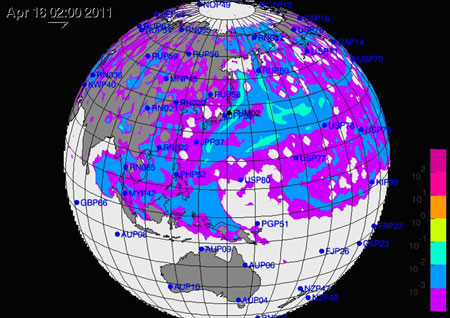Radioactivity in the air in Hanoi tends to decrease
In the evening of April 14, the Institute of Nuclear Science and Technology (Vietnam Atomic Energy Institute) announced that the level of radioactivity measured in Hanoi is very low and tends to decrease.
According to experts, radioactivity measured in the air in Hanoi is I-131, Cs-134 and Cs-137 is at a very low threshold and tends to decrease. On April 14, the monitoring stations of the Nuclear Research Institute (Vietnam Atomic Energy Institute) continued to record radioactive substances in the air in Da Lat and Ho Chi Minh City at a very low level. does not affect human health and the environment.
According to experts, radioactive clouds exist in Southeast Asia, continuing to spread to India and down to the Southern Hemisphere. However, the concentration of radionuclides measured at monitoring stations in Southeast Asia is hundreds of times lower than permitted and does not change the current radiation background in the region.

Image simulating radioactive clouds for Southeast Asia, predicted at 2:00 pm on April 16.(Image source: VAEI).
On April 14, the Vietnamese Ministry of Science also informed about the situation in Japan. Specifically, Japan said it found a small amount of radioactive strontium (Sr) in soil and plants outside the range of 30 km from the Fukushima plant 1.
However, the Ministry of Education, Culture, Sports, Science and Technology (MEXT) said that the level of strontium detected is very small, does not affect human health.
According to expert opinion, the presence of strontium proves that the fuel in the reactor or fuel burned in the tank has been damaged and strontium is released after the hydrogen gas explosion at Unit 3.
On April 13, TEPCO said the radiation level measured off Fukushima to the highest level in the past 3 weeks. Specifically, at the sampling point 30 km from the Fukushima I factory to the East, I-131 was measured at 88.5 Bq / l on April 11, 2.2 times the permitted limit for muscle waste water. At the nuclear facility, the measured Cs-137 is also at its highest level in the past few weeks, but is still smaller than the allowable limit. At the sampling point 15 km away from the factory, I-131 is 23 times the permissible limit. Meanwhile, radioactive measurement results in waters near the factory tend to decrease rapidly.
- Radioactive clouds spread to Hanoi
- Video: A rare film about Hanoi street 50 years ago
- There are 5 points in Vietnam that detect radioisotopes
- Hanoi winter moments
- Ice appears in the North
- Radioactivity in Tokyo does not come from Fukushima
- The temperature in Sa Pa continues to decrease to minus 2 degrees Celsius
- Radiation detection is 10 times higher in Japan
- He did not touch goods to Hanoi in 1992
- Radioactivity in the air of Vietnam plummeted
- Radioactive remains
- A series of photos to live in Hanoi 20 years ago by Yvan Cohen
 Is the magnetic North Pole shift dangerous to humanity?
Is the magnetic North Pole shift dangerous to humanity? Washington legalizes the recycling of human bodies into fertilizer
Washington legalizes the recycling of human bodies into fertilizer Lightning stone - the mysterious guest
Lightning stone - the mysterious guest Stunned by the mysterious sunset, strange appearance
Stunned by the mysterious sunset, strange appearance